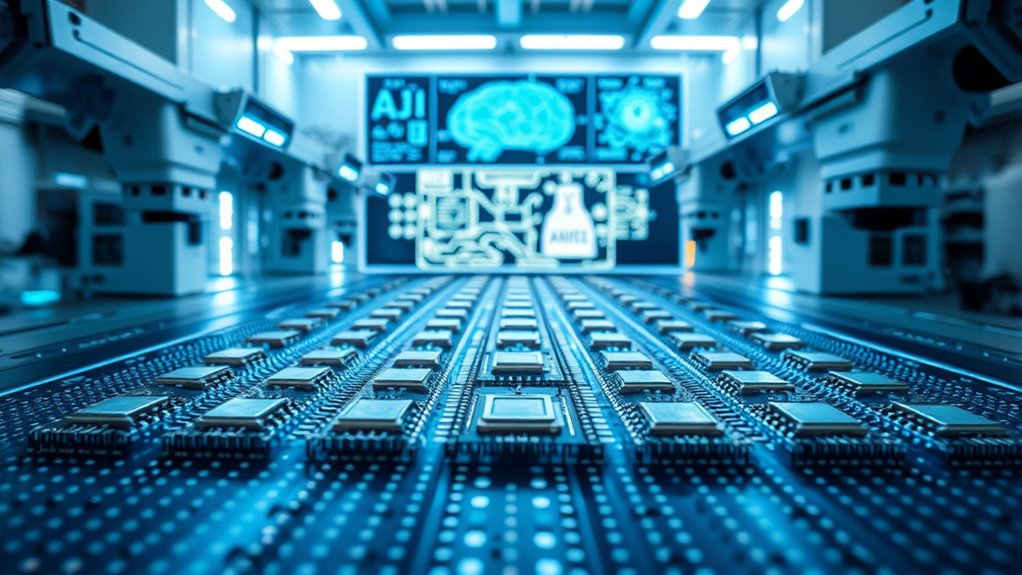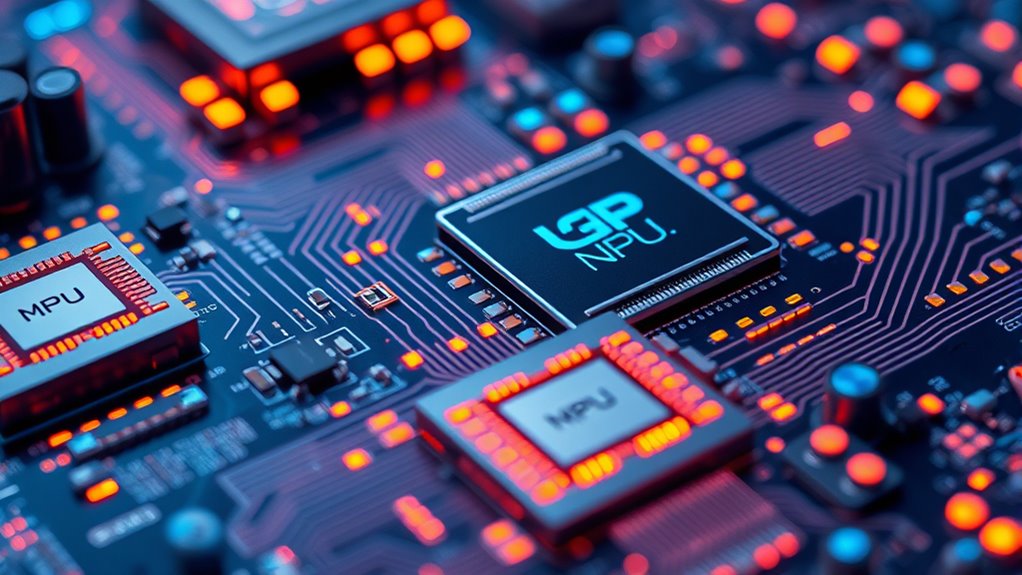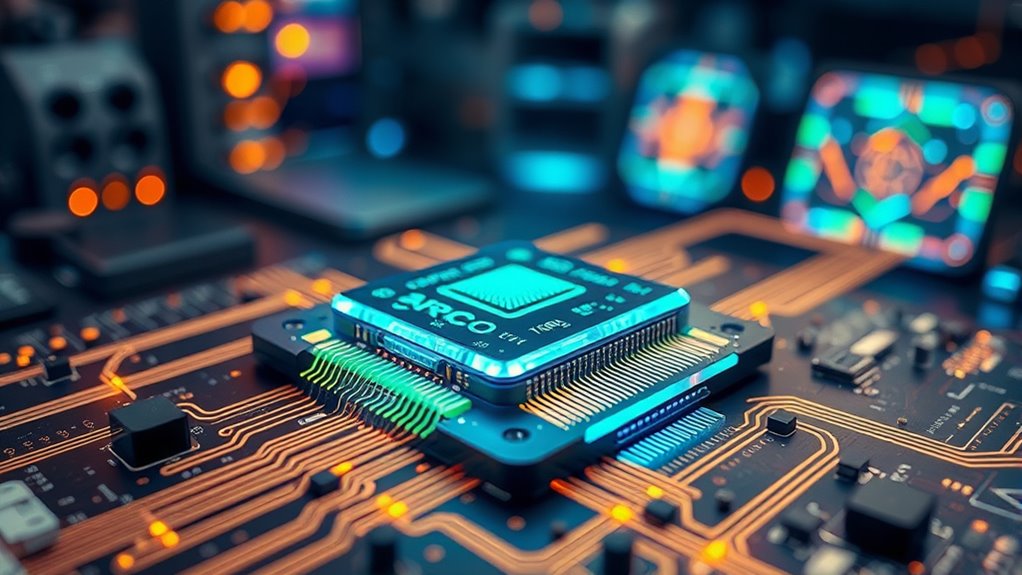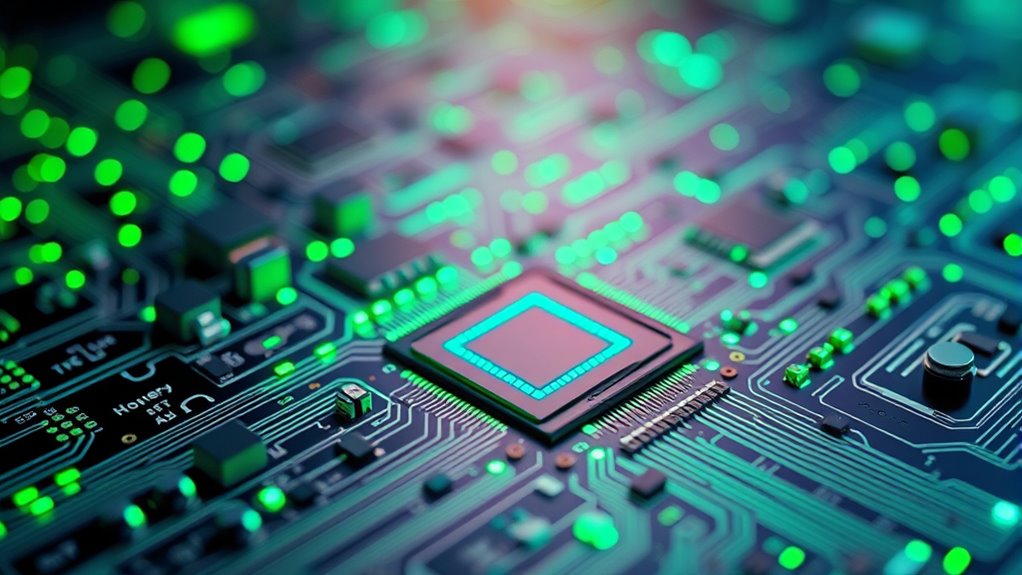The AI hardware revolution is driven by advancements in fabrication tech, like TSMC’s 5nm process, boosting performance and lowering costs. Innovative architectures, including GPUs and NPUs, enhance speed and efficiency for smarter AI systems. Industry infrastructure now supports large-scale applications across sectors, fueled by fierce competition among chipmakers. Ongoing innovations will push AI capabilities even further, enabling more powerful and scalable solutions — if you want to explore how these new chips are shaping smarter AI, there’s more to discover.
Key Takeaways
- Advancements in fabrication technology, like TSMC’s 5nm nodes, enable higher transistor density for faster, more efficient AI chips.
- Architectural innovations in GPUs and NPUs optimize parallelism and energy efficiency, enhancing AI performance.
- Custom silicon tailored for AI workloads accelerates processing speed and scalability across diverse applications.
- Industry collaborations and competitive innovation drive the development of next-generation AI hardware solutions.
- Future chips will support larger models and real-time AI tasks, fueling smarter, more capable AI systems.
Cutting-Edge Fabrication Technologies Boost AI Performance

Advancements in fabrication technologies are transforming AI hardware by enabling faster, more efficient chips. When you use cutting-edge processes like TSMC’s 5nm node, you benefit from higher transistor density, which boosts performance and reduces power consumption. This also supports sound wave influence on brainwave patterns, contributing to more sophisticated AI capabilities. Smaller transistors allow for increased parallelism, improving both training and inference speeds. You’ll notice lower latency and higher throughput, essential for real-time applications. These manufacturing innovations also support scalable AI solutions, from edge devices to massive data centers. By pushing the limits of chip miniaturization, fabrication tech guarantees AI hardware can meet growing demands, opening new possibilities in AI research, deployment, and enterprise use. Additionally, advancements in fabrication technologies contribute to reduced manufacturing costs, making high-performance AI hardware more accessible across various sectors. As a result, the continuous development of advanced fabrication techniques is critical for maintaining the pace of innovation in AI hardware. Moreover, improved fabrication methods help address AI hardware scalability, ensuring that future AI systems can expand efficiently as computational needs grow.
Innovations in GPU and NPU Architectures Drive AI Capabilities

Innovations in GPU and NPU architectures are transforming AI capabilities by delivering unprecedented speed and efficiency. You now benefit from specialized hardware that accelerates complex computations, reduces latency, and handles larger models. Modern GPUs feature advanced parallel processing cores, dynamic scheduling, and optimized memory access, boosting training and inference. NPUs, designed specifically for neural network workloads, excel at high-throughput, low-power AI tasks, especially at the edge. These innovations enable real-time AI applications, multi-modal processing, and scalable deployments. Additionally, hardware acceleration plays a crucial role in pushing the boundaries of AI performance and efficiency. The integration of advanced processing units allows for more specialized tasks to be handled more effectively, further enhancing AI capabilities. By leveraging power-efficient architectures, developers can achieve sustainable growth in AI deployment without compromising performance. As a result, these hardware advancements are driving the future of AI technology, making it more accessible and powerful across various sectors. Moreover, ongoing research into energy-efficient architectures ensures sustainable growth in AI deployment.
Enterprise-Grade AI Infrastructure Shapes Industry Applications

Enterprise-grade AI infrastructure is transforming how industries deploy and scale AI solutions. You now have access to integrated systems that combine GPU servers, advanced networking, and specialized AI software, creating a seamless workflow. This infrastructure enables you to run complex workloads like digital twins, simulations, and multi-modal inference efficiently. With cloud marketplaces and on-premises AI factories, you gain flexibility, control, and security, addressing data privacy concerns. Partnerships with firms like Nvidia, Cadence, and Foxconn streamline deployment across sectors such as healthcare, manufacturing, and finance. You can now harness scalable, high-performance AI hardware to accelerate innovation, automate processes, and extract deeper insights. This evolution empowers your organization to implement smarter, industry-specific AI applications, driving digital transformation at an unprecedented pace.
Market Trends and Competition Fuel Rapid Hardware Advancements

The rapidly growing demand for specialized AI hardware is driving fierce competition among manufacturers, fueling swift technological progress. You’ll notice companies like NVIDIA, TSMC, and Samsung pushing the boundaries with advanced fabrication processes, such as TSMC’s 5nm technology, boosting performance and energy efficiency. Emerging players are developing diverse architectures—GPUs, NPUs, and TPUs—tailored for high-speed AI tasks. This competitive landscape fosters rapid innovation, with firms endeavoring to improve speed, reduce latency, and optimize power consumption. Market dynamics are also shaped by the global manufacturing ecosystem, where U.S. design leadership meets Asia’s fabrication strength. As a result, hardware advances accelerate, enabling more scalable, efficient AI solutions across industries, and fueling a cycle of continuous improvement driven by strategic rivalry. Wall organization systems, for example, can be integrated into hardware setups to enhance overall system performance and maintainability. Additionally, the integration of specialized AI chips further accelerates processing capabilities, enabling real-time data analysis and decision-making. These advancements are closely tied to Innovation and Discovery, which continues to propel the industry forward. Moreover, ongoing research in lifestyle can influence user interface design, making AI hardware more accessible and user-friendly. Furthermore, developments in advanced fabrication processes are essential for achieving the performance gains necessary to meet growing AI demands.
Future Perspectives: Scaling AI With Next-Generation Chips

As AI workloads continue to grow in complexity and scale, next-generation chips are poised to play a pivotal role in meeting these demands. You’ll see advancements that enable more efficient large-scale training and inference. Consider these key trends:
- Multi-GPU coordination will become essential for handling massive models, allowing seamless distributed processing.
- Specialized inference frameworks will optimize performance for generative AI and large language models.
- Cloud marketplaces will simplify access, making powerful AI hardware more democratized and flexible.
- Hybrid infrastructures combining on-premises AI factories with cloud resources will enhance scalability and control.
- The integration of neural networks into hardware accelerates predictive capabilities, enabling smarter AI systems with faster processing speeds. Additionally, innovations in chip architecture are driving improvements in energy efficiency and computational power, further supporting complex AI applications. These advancements are also contributing to energy-efficient processing, which is crucial as AI models become more resource-intensive. Moreover, ongoing research into thermal management is vital for maintaining performance and longevity of advanced chips under intensive workloads. Furthermore, the development of custom silicon tailored specifically for AI workloads enhances overall system efficiency and performance.
These innovations will accelerate AI’s evolution, pushing capabilities further and facilitating new applications across industries. Your ability to leverage these next-generation chips will define the future of smarter, more scalable AI systems.
Frequently Asked Questions
How Do AI Chips Differ From Traditional CPUS in Performance?
AI chips outperform traditional CPUs by delivering much higher parallel processing power, which speeds up AI tasks like training and inference. They use specialized architectures such as GPUs, NPUs, or TPUs, optimized for matrix operations and high-speed data flow. You’ll notice faster results, lower latency, and greater energy efficiency, especially when handling large-scale AI models, making them essential for advanced AI applications compared to general-purpose CPUs.
What Role Does Software Optimization Play in AI Hardware Efficiency?
They say, “A chain is only as strong as its weakest link.” Software optimization plays a vital role in AI hardware efficiency by maximizing hardware capabilities, reducing latency, and improving throughput. You can’t just rely on powerful chips alone; fine-tuning frameworks like PyTorch and TensorRT-LLM ensures models run faster, consume less energy, and deliver better results. This synergy releases the full potential of AI hardware, making your AI solutions smarter and more efficient.
Are There Environmental Impacts Associated With Advanced AI Chip Manufacturing?
Yes, advanced AI chip manufacturing impacts the environment. You might notice increased energy consumption during fabrication, especially with cutting-edge processes like TSMC’s 5nm technology. The production involves resource-intensive materials and generates electronic waste. However, manufacturers are working to reduce these effects by improving energy efficiency, recycling materials, and adopting greener practices. Still, it is crucial to stay aware of these environmental concerns as AI hardware continues to evolve.
How Secure Are On-Premises AI Factories Compared to Cloud Solutions?
Imagine a fortress guarding your treasures—that’s how secure on-premises AI factories are compared to cloud solutions. You control physical access, data, and security protocols directly, reducing exposure to external breaches. While cloud providers invest heavily in security, your local setup minimizes risks from cyber-attacks and insider threats. With proper safeguards, your on-site AI infrastructure offers a robust, tailored security environment, giving you peace of mind in safeguarding sensitive AI data.
What Are the Main Challenges in Scaling AI Hardware for Global Deployment?
You face challenges like maintaining performance consistency across diverse regions, managing high energy consumption, and ensuring robust cooling solutions. Supply chain disruptions can delay hardware deployment, while integrating new tech requires significant expertise. Scaling AI hardware globally also involves addressing local infrastructure limitations and regulatory compliance. To succeed, you need flexible designs, scalable architectures, and strategies that adapt to varying environmental and logistical conditions worldwide.
Conclusion
You’re witnessing an AI hardware revolution, where innovations in fabrication, architecture, and infrastructure accelerate your capabilities. As market trends drive competition, and next-generation chips push boundaries, your AI systems become smarter, faster, and more efficient. Embrace these advancements, adapt to the evolving landscape, and harness the power of cutting-edge hardware to unleash new possibilities. Stay ahead, stay innovative, and let these technological breakthroughs shape your journey into the future of AI.









